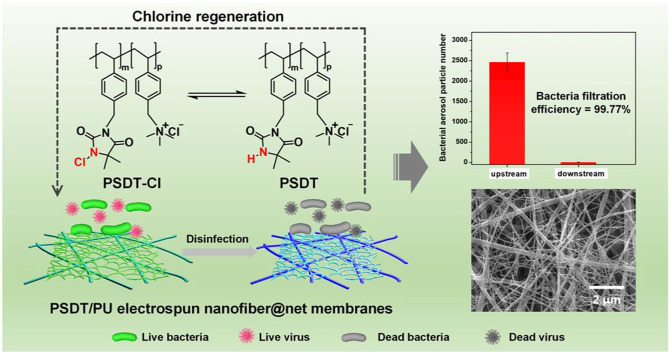- Record: found
- Abstract: found
- Article: not found
Antibacterial and antiviral N-halamine nanofibrous membranes with nanonet structure for bioprotective applications

Abstract
The recent outbreak of a coronavirus disease (COVID-19) has posed a great threat to public health and financial system. Most current masks used to prevent the spread of COVID-19 are typically absence of biocidal properties. We designed a novel polymer, polystyrene grafted by 5, 5-dimethylhydantoin and trimethylamine (PSDT), which possesses halamine site and cationic quaternary ammonia salt site. Furthermore, PSDT/PU nanofiber@net membranes (PSDT/PU NNMs) were obtained by electrospinning technology. Our strategy enables inherent N-halamine and quaternary ammonia salt (QAS) group to be covalently integrated into membranes, realizing the efficient and stable biocidal properties. Meanwhile, the introduction of nanonets endows electrospun membranes with prominent air filtration performance. The resulting membranes exhibit integrated properties of high interception of fine particles (96.7%) and low pressure drop (95.4 Pa). Besides, chlorinated PSDT/PU nanofiber@net membranes (with active chlorine content of 0.60 wt% and quaternary ammonia salt content of 2.20 wt%) exhibited superior bactericidal (>99.9999%) and virucidal (>99.999%) efficiency in a short time (2 min), which enables chlorinated PSDT/PU NNMs to be served as the filtration material by providing bacterial interception (99.77%) and contact killing against pathogens. The successful synthesis of PSDT/PU NNMs provide innovative insights for exploring filtration materials in a nanonet and biocidal form.
Graphical abstract
Related collections
Most cited references54
- Record: found
- Abstract: found
- Article: found
Clinical Characteristics of 138 Hospitalized Patients With 2019 Novel Coronavirus–Infected Pneumonia in Wuhan, China
- Record: found
- Abstract: found
- Article: not found
Ultralight nanofibre-assembled cellular aerogels with superelasticity and multifunctionality.
- Record: found
- Abstract: found
- Article: not found
